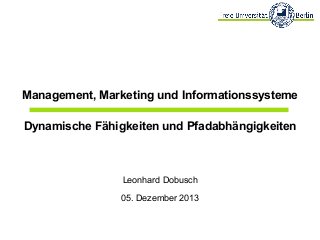
Management, Marketing und Informationssysteme - Dynamische Fähigkeiten und Pfadabhängigkeiten
- 1. Management, Marketing und Informationssysteme Dynamische Fähigkeiten und Pfadabhängigkeiten Leonhard Dobusch 05. Dezember 2013
- 2. Diskussion der Vorablektüre Schreyögg/Kliesch-Eberl (2007): How dynamic can organizational capabilities be? Gruppe 1: § Schließen sich Flexibilität und Stabilität gegenseitig aus oder kann auch beides gleichzeitig erreicht werden? § Warum gibt es in der Literatur keine einheitliche, sondern viele unterschiedliche Auffassungen von "Capability"? Gruppe 2: § Welche Personen einer Organisation sollten das capability monitoring durchführen? § Inwiefern unterscheidet sich das Capability Monitoring vom Total Quality Management Ansatz? Prof. Dr. Leonhard Dobusch, Freie Universität Berlin
- 3. Diskussion der Vorablektüre Dobusch (2010): Kaskaden der Komplementarität Gruppe 3: § Warum steigt die Zurückhaltung beim Einsatz von freier/ Open Source Software tendenziell mit der Größe eines Unternehmens? § Wie kann man den Ängsten der Mitarbeiter bzgl. des Knowhow- und Kompetenzverlusts effektiv begegnen? Gruppe 4: § Birgt komplette Umstrukturierung wie in München nicht wieder die Gefahr einer Pfadabhängigkeit? Besser wie in Wien? § Was versteht man unter "schützende Unwissenheit" die Hirschmann als "hiding Hand" bezeichnet genau? Prof. Dr. Leonhard Dobusch, Freie Universität Berlin
- 4. Dynamische Fähigkeiten: Konzept Teece et al. (1997): „Dynamic Capabilities and Strategic Management“ Weiterentwicklung des „Kernkompetenzansatzes“ § Spezifische Ressourcenkombination § Fokus auf eigene Organisation als Bündel von Fähigkeiten § Aber: Versuch einer Prozessperspektive Drei zentrale Fähigkeiten: § Erkennen von Gelegenheiten und Chancen § Gelegenheiten ergreifen § Verbessern, Re-kombinieren und Schützen von Investments Prof. Dr. Leonhard Dobusch, Freie Universität Berlin
- 5. Auf der Flucht vor Pfadabhängigkeiten? Teece et al. (1997: 516): „We define dynamic capabilities as the firm's ability to integrate, build, and reconfigure internal and external competences to address rapidly changing environments. Dynamic capabilities thus reflect an organization's ability to achieve new and innovative forms of competitive advantage given path dependencies and market positions (LeonardBarton, 1992).“ Prof. Dr. Leonhard Dobusch, Freie Universität Berlin
- 6. Core Capabilities oder Core Rigidities? Aus: Leonard-Barton (1992), S. 114 Prof. Dr. Leonhard Dobusch, Freie Universität Berlin
- 7. Dilemma: Exploitation oder Exploration? March (1991): § Exploration: „search, variation, risk taking, experimentation, play, flexibility, discovery, innovation“ § Exploitation: „refinement, choice, production, efficiency, selection, implementation, execution“ These: unauflösbares Dilemma zwischen kurzfristig effizienter Exploitation und langfristig effizienter Exploration >> „Arbeitsteilung“ zwischen unterschiedlichen Firmen auf Marktebene Prof. Dr. Leonhard Dobusch, Freie Universität Berlin
- 8. Ausweg Ambidexterität (“Beidhändigkeit”)? Strukturell Kontextuell Ebene Organisationsstruktur (spezialisierte Bereiche) Individuum (Aufteilung der Arbeitszeit) Entscheidung Organisationsleitung Organisationsmitglieder Rollenprofilee Klar definiert Flexibel Kompetenzprofile Spezialisten Generalisten Nach: Birkinshaw/Gibson (2004), S. 50 Prof. Dr. Leonhard Dobusch, Freie Universität Berlin
- 9. Ausweg “capability monitoring”? Aus: Schreyögg/Kliesch-Eberl(2004), S. 926 Prof. Dr. Leonhard Dobusch, Freie Universität Berlin
- 10. Pfadabhängigkeit trotz Monitoring? Aus: Sydow et al. (2009), S. 692 Prof. Dr. Leonhard Dobusch, Freie Universität Berlin
- 11. Selbstverstärkende Mechanismen Mechanismus Fokus 1 Koordinations- und Netzwerkeffekte Nutzenvorteile bei koordiniertem Verhalten 2 Komplementaritäten Synergien von Kopplung 3 Lernen Intransferable knowledge 4 Adaptive Erwartungen Increasing standardization … à Einer oder mehrere Mechanismen? Prof. Dr. Leonhard Dobusch, Freie Universität Berlin
- 12. Pfadabhängigkeit im Fall von Windows Microsoft Netzeffekte auf Marktebene Marktebene EXTERN Marktebene EXTERN Organisationale Ebene INTERN Organisationale Ebene INTERN Organisationale Dezentralisierung Induziert/stabilisiert induziert/fördert Autonomie durch Adaption an technologische Plattform Komplementarität Vielfalt plattformspezifischer Software Komplementarität Plattformspezifisches individuelles/ organ. Lernen Prof. Dr. Leonhard Dobusch, Freie Universität Berlin
- 13. Hausarbeit: Meilensteine (1) Erstellung eines Kurz-Exposés (bis 11.12.2013) § Forschungsinteresse: Fragestellung? Unterfragen? Relevanz? § Theoriewahl: Welche theoretischen Ansätze? § Herangehensweise: Welche Methoden? Geplantes Vorgehen? (2) Feedback zum Exposé (12.12.2013) (3) Recherche- und Schreibphase (bis 31.01.2014) (4) Zwischenworkshop (31.01.2014) § Kurzvortrag & Feedback (10min + 5min) (5) Überarbeitungsphase (bis 28.02.2014) Prof. Dr. Leonhard Dobusch, Freie Universität Berlin
- 14. Literatur § Birkinshaw, J./Gibson, C. (2004): Building Ambidexterity in an Organization. In: MIT Sloan Management Review, 47-55 § Leonhard-Barton, D. (1992): Core Capabilities and Core Rigidities: A Paradox in Managing New Product Development. In: Strategic Management Journal, 13, 111-125. § March, J.G. (1991): Exploration and Exploitation in Organizational Learning. In: Organization Science, 2(1), 71-87 § Teece, D.J./Pisano, G./Shuen, A. (1997): Dynamic Capabilities and Strategic Management. In: Strategic Management Journal, 18 (7), 509-533 § Sydow, J./Schreyögg, G./Koch, J. (2009): Organizational Path Dependence: Opening the Black Box. Academy of Management Review, 34 (4), 689-709 Prof. Dr. Leonhard Dobusch, Freie Universität Berlin
